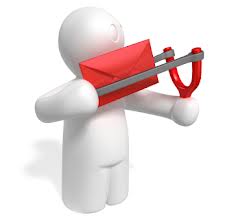 With all of the social media services out there, sometimes you miss the one right in front of you. The one that most people use every single day. No it’s not Facebook. It’s not twitter. It’s email.
With all of the social media services out there, sometimes you miss the one right in front of you. The one that most people use every single day. No it’s not Facebook. It’s not twitter. It’s email.
I know many of you are probably scratching your head and thinking that email isn’t part of the social media family, which is the position Peter Kim takes in his blog. Derek Halpern at DIY Themes blog makes the case for the other side. While I don’t want to engage in a debate over this question, I know these two things when it comes to email:
- People seem to use it for social purposes all of the time (e.g. organizing meetings, polling opinions, marketing, etc)
- People seem to use it to drive online traffic to their website and social media platforms (e.g. Facebook, Twitter, etc).
Email can be used in many of the same ways as many of the social media sites. It is a great way to get news out to your organization’s supporters, share photos and redirect people to your online platforms.
The great thing about email is that it is a tool that people are used to using, and it is something about which they don’t need to learn anything new. Why does this matter? Well, it significantly increases the likelihood of people reading your content.
Today, we are going to take a brief look at a few services that can help your agency make the most out of email.
Constant Contact is a paid service that can provide email marketing services to non-profits. They are a trusted name in email services for small businesses as well. Here are some features Constant Contact offers:
- Email templates
- Coaching & support
- Social media links
- Social media stats / analytics
Click here to access an online manual about how to access and use more advanced features associated with this service.
 Other email marketing services
Other email marketing services
It feels like Constant Contact is the “Gold Standard” of email marketing services, especially if you pay attention to the television, radio and online advertising. However, I see a number of my non-profit friends using other services such as:
There is even one company out there — VerticalResponse — who offers a free service for non-profit organizations. While I suspect it is a scaled back version with limited features, it is something you may want to check out.
Develop a strategy
 As with every other aspect of your ePhilanthropy and marketing program, you need to develop a strategy because “hope is not a strategy”. The following are just a few questions to help you get started:
As with every other aspect of your ePhilanthropy and marketing program, you need to develop a strategy because “hope is not a strategy”. The following are just a few questions to help you get started:
- Who is our target audience?
- How should we build our agency’s email house file?
- How often should we communicate with this group?
- How does email marketing fit into our agency’s cross-channel communication strategy?
- What type of content should we develop for this communication tool?
- How do we prevent this tool from feeling like “one-way” communication and turn it into more of a two-way communication vehicle?
Our friends at about.com published a great article titled “Nine Strategies for Smart Email Marketing” that you may want to check out.
Does your non-profit agency use email marketing as part of its marketing and ePhilanthropy plan? How is that going for you? What service do you use? Are you happy with it? What would you do differently if you had a chance to do it over again? Please share your thoughts in the comment box below.





